
|
|
How to Use the MACD Indicator 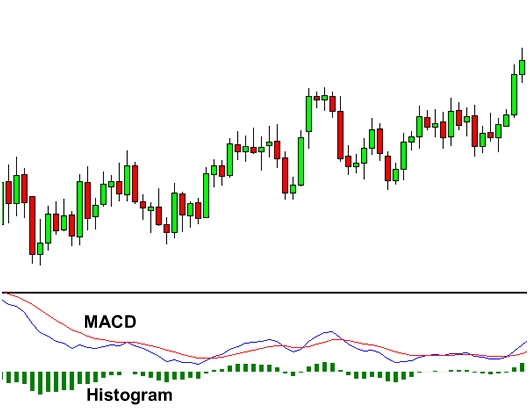 With an MACD chart, you will usually see three numbers that are used for its settings.
In our example above, the faster moving average is the moving average of the difference between the 12 and 26-period moving averages. The slower moving average plots the average of the previous MACD line. Once again, from our example above, this would be a 9-period moving average. This means that we are taking the average of the last 9 periods of the faster MACD line and plotting it as our slower moving average. This smoothness out the original line even more, which gives us a more accurate line. The histogram simply plots the difference between the fast and slow moving average. If you look at our original chart, you can see that, as the two moving averages separate, the histogram gets bigger. This is called divergence because the faster moving average is “diverging” or moving away from the slower moving average. As the moving averages get closer to each other, the histogram gets smaller. This is called convergence because the faster moving average is “converging” or getting closer to the slower moving average. Ok, so now you know what MACD does. Now we’ll show you what MACD can do for YOU. How to Trade Using MACD ? Because there are two moving averages with different “speeds”, the faster one will obviously be quicker to react to price movement than the slower one. When a new trend occurs, the fast line will react first and eventually cross the slower line. When this “crossover” occurs, and the fast line starts to “diverge” or move away from the slower line, it often indicates that a new trend has formed. 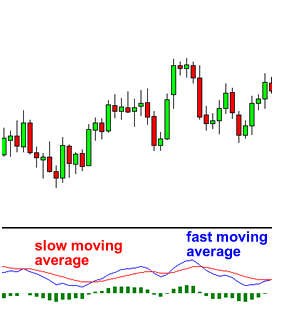 From the chart above, you can see that the fast line crossed under the slow line and correctly identified a new downtrend. Notice that when the lines crossed, the histogram temporarily disappears. This is because the difference between the lines at the time of the cross is 0. As the downtrend begins and the fast line diverges away from the slow line, the histogram gets bigger, which is good indication of a strong trend. 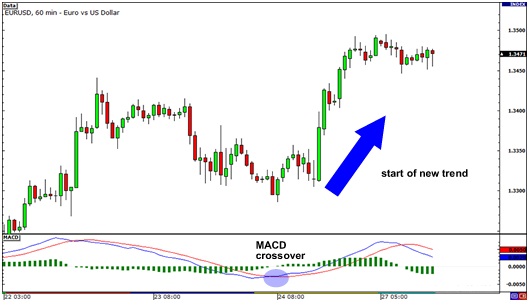 Let’s take a look at an example. In EUR/USD’s 1-hour chart above, the fast line crossed above the slow line while the histogram disappeared. This suggested that the brief downtrend would eventually reverse. From then, EUR/USD began shooting up as it started a new uptrend. Imagine if you went long after the crossover, you would’ve gained almost 200 PROFITs! There is one drawback to MACD. Naturally, moving averages tend to lag behind price. After all, it’s just an average of historical prices. Since the MACD represents moving averages of other moving averages and is smoothed out by another moving average, you can imagine that there is quite a bit of lag. However, MACD is still one of the most favored tools by many traders. How to Use RSI (Relative Strength Index) Relative Strength Index, or RSI, is similar to the stochastic in that it identifies overbought and oversold conditions in the market. It is also scaled from 0 to 100. Typically, readings below 30 indicate oversold, while readings over 70 indicate overbought. 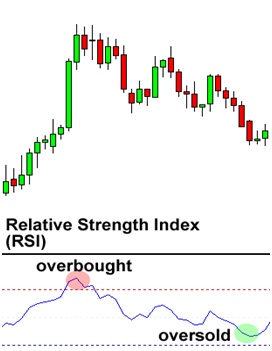  How to Trade Using RSI RSI can be used just like the stochastic. We can use it to pick potential tops and bottoms depending on whether the market is overbought or oversold. Below is a 4-hour chart of EUR/USD. EUR/USD had been dropping the week, falling about 400 PROFITs over the course of two weeks. On June 7, it was already trading below the 1.2000 handle. However, RSI dropped below 30, signalling that there might be no more sellers left in the market and that the move could be over. Price then reversed and headed back up over the next couple of weeks. Determining the Trend using RSI RSI is a very popular tool because it can also be used to confirm trend formations. If you think a trend is forming, take a quick look at the RSI and look at whether it is above or below 50. If you are looking at a possible uptrend, then make sure the RSI is above 50. If you are looking at a possible downtrend, then make sure the RSI is below 50. 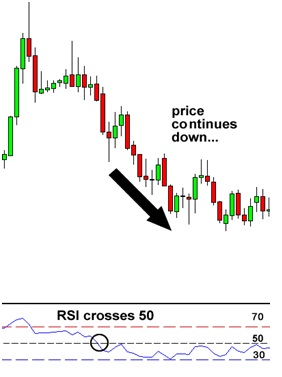 How to Use ADX (Average Directional Index) The Average Directional Index, or ADX for short, is another example of an oscillator. It fluctuates from 0 to 100, with readings below 20 indicating a weak trend and readings above 50 signaling a strong trend. Unlike the stochastic, ADX doesn’t determine whether the trend is bullish or bearish. Rather, it merely measures the strength of the current trend. Because of that, ADX is typically used to identify whether the market is ranging or starting a new trend. Take a look at these neat charts we’ve pulled up: 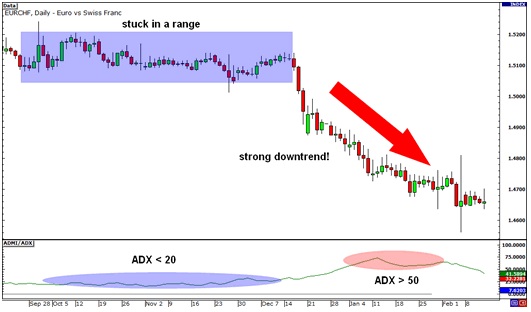 In this first example, ADX lingered below 20 from late September until early December. As you can see from the chart, EUR/CHF was stuck inside a range during that time. Beginning in January though, ADX started to climb above 50, signalling that a strong trend could be waiting in the wings. And would you look at that! EUR/CHF broke below the bottom of the range and went on a strong downtrend. Ooh, that’d be around 400 PROFITs in the bag. How to Trade Using ADX One way to trade using ADX is to wait for breakouts first before deciding to go long or short. ADX can be used as confirmation whether the pair could possibly continue in its current trend or not. Another way is to combine ADX with another indicator, particularly one that identifies whether the pair is headed downwards or upwards. ADX can also be used to determine when one should close a trade early. For instance, when ADX starts to slide below 50, it indicates that the current trend is losing steam. From then, the pair could possibly move sideways, so you might want to lock in those PROFITs before that happens. |
